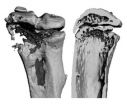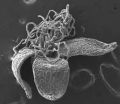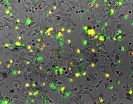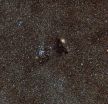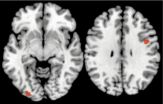(Press-News.org) Cancer drugs should kill tumors, not encourage their spread. But new evidence suggests that an otherwise promising class of drugs may actually increase the risk of tumors spreading to bone, according to researchers at Washington University School of Medicine in St. Louis.
The drugs, IAP antagonists, block survival signals that many cancer cells rely on to stay alive. Working in mice, the investigators found that targeting the same protein that makes tumors vulnerable to death also overactivates cells called osteoclasts, which are responsible for tearing down bone.
"These investigational drugs are getting broad attention right now because they seem to be very effective against primary tumors," says senior author Deborah V. Novack, MD, PhD, associate professor of medicine. "There is also excitement because until now, these drugs have not appeared to have major side effects."
The research appears in the February issue of Cancer Discovery.
In light of the study, Novack urges oncologists to think about protecting bone in patients taking IAP antagonists, including patients with cancers that don't typically spread to bone. Numerous IAP antagonists are in early clinical trials against breast, lung, pancreatic, ovarian, prostate, liver, skin and blood cancers.
"For many of these cancers, doctors are not watching bone," Novack says. "Osteoporosis is not the biggest concern when treating cancer, but if they're not doing bone scans, they may miss a cancer spreading to bone."
To maintain healthy bone, osteoclasts work in tandem with cells that build new bone. But IAP antagonists overactivate osteoclasts, destroying bone that is not replaced. In mice, the researchers showed that the drug led to osteoporosis, creating an environment that encouraged tumor growth in degrading bone, even while simultaneously killing breast cancer cells elsewhere.
After showing that the problem with IAP antagonists is specific to bone, Novack and her colleagues tested long-established drugs called bisphosphonates that inhibit osteoclasts and are used to treat osteoporosis.
"We found that bisphosphonate treatment protected bone from the negative effects of these drugs," Novack says. "While bisphosphonates are common for breast cancer patients, they're not, for example, commonly given to lung cancer patients. But since IAP antagonists are now in lung cancer trials, we're saying doctors may want to consider bisphosphonate treatment for lung cancer or other cancer patients receiving these drugs. Or at least closely monitor the bone status."
IAP antagonists are now only available to patients enrolled in phase 1 or 2 clinical trials. While these kinds of trials examine the short-term safety and effectiveness of new drugs, the researchers say they may not catch bone metastasis.
"These trials do not necessarily look for long-term effects of the drugs," says Chang Yang, MD, PhD, staff scientist and the paper's first author. "If the cancer is going to metastasize to bone, it may take six months to two years to see that outcome. This may not be seen during the clinical trial."
Numerous drug companies are developing IAP antagonists intended for many kinds of cancer, but only Genentech agreed to provide Novack and her colleagues with its drug, called BV6, to evaluate in the study. Because the investigators could not obtain other proprietary IAP antagonists, they also made two other similar drug compounds and found them to have the same detrimental effects on the bone.
And to further ensure that over-stimulated osteoclasts are the only culprit in the bone metastasis associated with these new drugs, they performed studies in mice that lack the ability to dial up the production of osteoclasts. Even when given IAP antagonists, these mice were protected from osteoporosis and osteoclast activation.
Together, Novack says the studies have demonstrated that these results are unlikely to be a quirk of a particular compound.
"The osteoporosis and spread of tumors we see in bone are unintended side effects of IAP antagonists, but they're not off-target effects," she says. "They're based on the mechanism of action for the entire class of drugs."
INFORMATION:
Yang C, Davis JL, Zeng R, Vora P, Su X, Collins LI, Vangveravong S, Mach RH, Piwnica-Worms D, Weilbaecher KN, Faccio R, Novack DV. Anticancer IAP inhibition increases bone metastasis via unexpected osteoclast activation. Cancer Discovery. February 2013.
This study was supported by the National Institutes of Health (NIH), grant number AR052705, with additional support from AR52921 and AR53628, CA100730, and the Barnes-Jewish Foundation. Histological and microCT analysis was supported in part by the Washington University Center for Musculoskeletal Research NIH/National Institute of Arthritis and Musculoskeletal and Skin Diseases (NIAMS), grant number AR057235. The Molecular Imaging Center was supported by NIH grant P50 CA94056. Genentech, Inc. provided BV6.
Washington University School of Medicine's 2,100 employed and volunteer faculty physicians also are the medical staff of Barnes-Jewish and St. Louis Children's hospitals. The School of Medicine is one of the leading medical research, teaching and patient care institutions in the nation, currently ranked sixth in the nation by U.S. News & World Report. Through its affiliations with Barnes-Jewish and St. Louis Children's hospitals, the School of Medicine is linked to BJC HealthCare.
Emerging cancer drugs may drive bone tumors
2013-02-13
ELSE PRESS RELEASES FROM THIS DATE:
Flu outbreaks modeled by new study of classroom schedules
2013-02-13
Classroom rosters combined with human-networking theory may give a clearer picture of just how infectious diseases such as influenza can spread through a closed group of people, and even through populations at large. Using high-school schedule data for a community of students, teachers, and staff, Penn State University's Marcel Salathé, an assistant professor of biology, and Timo Smieszek, a post-doctoral researcher, have developed a low-cost but effective method to determine how to focus disease-control strategies based on which individuals are most likely to spread the ...
Does race make a difference in monitoring of opioid pain therapy?
2013-02-13
Philadelphia, PA, February 12, 2013 – Opioids are frequently prescribed for pain management in noncancer patients, but recommended clinical guidelines for monitoring effectiveness and signs of drug abuse are often not implemented. Alongside well-documented racial disparities in prescribing opioid medications for pain, researchers report racial differences in the use of recommended opioid monitoring and follow-up treatment practices. The study is published in the current issue of PAIN®.
"In our study, we examined whether racial disparities exist in a more comprehensive ...
Ice age extinction shaped Australian plant diversity
2013-02-13
Researchers have shown that part of Australia's rich plant diversity was wiped out by the ice ages, proving that extinction, instead of evolution, influences biodiversity.
The research led by the University of Melbourne and University of Tasmania has shown that plant diversity in South East Australia was as rich as some of the most diverse places in the world, and that most of these species went extinct during the ice ages, probably about one million years ago.
The team's work was published in the prestigious journal Proceedings of the National Academy of Sciences.
Dr ...
Flood research shows human habits die hard
2013-02-13
New research has come up with ways to quickly assess flood damage to houses while also showing most people didn't intend to make changes to reduce their vulnerability after the 2010-11 floods in Australia.
Two separate reports from the National Climate Change Adaptation Research Facility released today show how lessons learned from households affected by the 2010-11 Australian floods can minimise damage under current and future climates.
The report Analysis of Damage to Buildings Following the 2010 Eastern Australia Floods evaluated the role of development controls ...
Blackbirds in the spotlight
2013-02-13
This press release is available in German.
Street lamps, traffic lights and lighting from homes are causing a rise in our night-time light levels. For some time now, scientists have suspected that artificial light in our towns and cities at night could affect plants, animals and us, humans, too. Studies, however, that have tested this influence directly are few. Scientists from the Max Planck Institute for Ornithology in Radolfzell, Germany, recently investigated how light conditions in urban areas at night affect European blackbirds (Turdus merula). They found that animals ...
Copper depletion therapy keeps high-risk triple-negative breast cancer at bay
2013-02-13
NEW YORK (February 13, 2013) -- An anti-copper drug compound that disables the ability of bone marrow cells from setting up a "home" in organs to receive and nurture migrating cancer tumor cells has shown surprising benefit in one of the most difficult-to-treat forms of cancer -- high-risk triple-negative breast cancer.
The median survival for metastatic triple-negative breast cancer patients is historically nine months. However, results of a new phase II clinical trial conducted by researchers at Weill Cornell Medical College and reported in the Annals of Oncology shows ...
UNC researchers discover gene that suppresses herpesviruses
2013-02-13
Chapel Hill, NC – Kaposi's sarcoma-associated herpesvirus (KSHV) and Epstein-Barr virus (EBV) hide within the worldwide human population. While dormant in the vast majority of those infected, these active herpesviruses can develop into several forms of cancer. In an effort to understand and eventually develop treatments for these viruses, researchers at the University of North Carolina have identified a family of human genes known as Tousled-like kinases (TLKs) that play a key role in the suppression and activation of these viruses.
In a paper published by Cell Host ...
'A drop of ink on the luminous sky'
2013-02-13
This part of the constellation of Sagittarius (The Archer) is one of the richest star fields in the whole sky -- the Large Sagittarius Star Cloud. The huge number of stars that light up this region dramatically emphasise the blackness of dark clouds like Barnard 86, which appears at the centre of this new picture from the Wide Field Imager, an instrument mounted on the MPG/ESO 2.2-metre telescope at ESO's La Silla Observatory in Chile.
This object, a small, isolated dark nebula known as a Bok globule [1], was described as "a drop of ink on the luminous sky" by its discoverer ...
Study suggests infant deaths can be prevented
2013-02-13
(TORONTO, Canada – Feb. 13, 2013) – An international team of tropical medicine researchers have discovered a potential method for preventing low birth weight in babies born to pregnant women who are exposed to malaria. Low birth weight is the leading cause of infant death globally.
The findings of Malaria Impairs Placental Vascular Development, published today online ahead of print in Cell Host & Microbe, showed that the protein C5a and its receptor, C5aR, seem to control the blood vessel development in the mother's placenta. Without adequate blood vessels in the placenta, ...
Carnegie Mellon brain imaging research shows how unconscious processing improves decision-making
2013-02-13
PITTSBURGH—When faced with a difficult decision, it is often suggested to "sleep on it" or take a break from thinking about the decision in order to gain clarity.
But new brain imaging research from Carnegie Mellon University, published in the journal "Social Cognitive and Affective Neuroscience," finds that the brain regions responsible for making decisions continue to be active even when the conscious brain is distracted with a different task. The research provides some of the first evidence showing how the brain unconsciously processes decision information in ways ...
